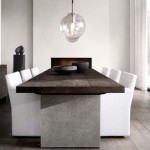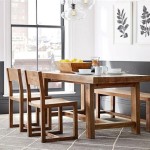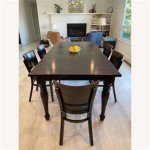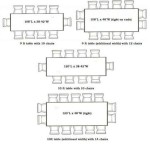Mid-Century Modern Circle Dining Table: A Timeless Design Icon
The Mid-Century Modern (MCM) aesthetic, a design movement born in the post-World War II era, continues to captivate with its clean lines, organic forms, and emphasis on functionality. Among the diverse array of furniture pieces that define this style, the Mid-Century Modern circle dining table stands out as a particularly compelling example. Its circular shape fosters connection and conversation, while its simple yet elegant design seamlessly integrates into a variety of interior spaces. This article delves into the key characteristics, historical context, variations, and enduring appeal of the Mid-Century Modern circle dining table.
The Mid-Century Modern movement flourished roughly from the mid-1940s to the late 1960s. It was a period of significant social and technological change, reflected in a design ethos that embraced optimism, progress, and a celebration of modern materials. Designers sought to create furniture that was both aesthetically pleasing and practical for everyday living. The emphasis was on uncluttered spaces, natural light, and furniture that served a purpose without being overly ornate. This philosophy contributed significantly to the popularity of the circle dining table, a piece that embodied these core principles.
The appeal of the circle dining table within the Mid-Century Modern context lies in its deviation from more traditional rectangular or square formats. The absence of corners promotes a more egalitarian dining experience, facilitating eye contact and encouraging a sense of inclusivity among diners. This design element resonated strongly with the era's focus on community and shared experiences. The round shape also often allowed for more efficient use of space, particularly in smaller homes and apartments, which were becoming increasingly common in urban areas.
Defining Characteristics of a Mid-Century Modern Circle Dining Table
Several key characteristics define the Mid-Century Modern circle dining table, distinguishing it from other styles. These features are often present in combination, contributing to the distinct and recognizable aesthetic of the piece.
Materials:
The materials used in constructing these tables were often a defining aspect of the overall design. Wood, particularly teak, walnut, and maple, was a prevalent choice, often finished with a clear coat to showcase the natural grain and color. These woods were prized for their durability, warm tones, and ability to be molded into sleek, organic forms. In some cases, wood was combined with other materials, such as metal legs or laminate tabletops, to create contrasting textures and visual interest.
Leg Design:
The legs of a Mid-Century Modern circle dining table are a crucial visual element. Common leg styles include tapered legs, often angled outwards for stability and visual flair. These legs were typically made of wood or metal, such as chrome or steel. Splayed legs, another popular option, provided a wider base and a more dynamic silhouette. Some tables featured pedestal bases, typically made of wood or metal, offering a clean and streamlined look. The leg design was always carefully considered to complement the shape and material of the tabletop, contributing to the overall balance and harmony of the piece.
Simplicity and Functionality:
True to the Mid-Century Modern ethos, these tables prioritized simplicity and functionality. Decorative elements were typically minimized, with the focus being on clean lines and elegant proportions. The design emphasized ease of use and maintenance. This functional approach extended to the table's size and capacity, often designed to comfortably accommodate a specified number of diners without being overly cumbersome. Some tables also included expandable leaves, allowing for greater flexibility in accommodating larger gatherings.Variations and Notable Designs
While the core characteristics of the Mid-Century Modern circle dining table remained fairly consistent, there were numerous variations in design and execution. These variations reflect the diverse creativity of the designers who embraced the style and the evolving tastes of the era.
The Saarinen Tulip Table:
Designed by Eero Saarinen in 1956, the Tulip table is perhaps one of the most iconic examples of Mid-Century Modern furniture. Its seamless, single-leg pedestal base, typically made of cast aluminum, provided a clean and uncluttered look. The tabletop was available in a variety of materials, including laminate, wood veneer, and marble. The Tulip table's minimalist design and organic form perfectly embodied the Mid-Century Modern aesthetic and continues to be a highly sought-after piece.
Drop-Leaf Circle Tables:
Recognizing the need for flexibility in smaller spaces, many Mid-Century Modern circle dining tables incorporated drop-leaf mechanisms. These tables featured two or more hinged leaves that could be folded down to reduce the table's size or extended to accommodate more diners. Drop-leaf tables provided a practical solution for those who wanted the functionality of a larger dining table without sacrificing valuable floor space when not in use.
Combination of Materials:
Beyond the standard wood and metal combinations, some designers experimented with incorporating other materials into their circle dining table designs. Glass tabletops were used to create a sense of lightness and transparency, while woven cane or rattan was sometimes incorporated into the table's base or apron for added texture and visual interest. These variations demonstrated the designers' willingness to push the boundaries of the Mid-Century Modern style while still adhering to its core principles.The Enduring Appeal of the Circle Dining Table
The Mid-Century Modern circle dining table continues to be a popular choice for homeowners and interior designers alike. Its enduring appeal can be attributed to a number of factors.
Timeless Design:
The clean lines, organic forms, and emphasis on functionality that define the Mid-Century Modern style have proven to be remarkably timeless. The design aesthetic transcends fleeting trends, remaining relevant and aesthetically pleasing across generations. A Mid-Century Modern circle dining table can seamlessly integrate into a variety of interior styles, adding a touch of sophistication and elegance to any space.
Social Dynamics:
As previously mentioned, the circular shape of the table fosters a sense of connection and conversation among diners. This aspect is particularly appealing in today's increasingly digital world, where opportunities for genuine human interaction are often limited. The circle dining table provides a natural setting for shared meals, engaging conversations, and creating lasting memories.
Versatility:
The Mid-Century Modern circle dining table is incredibly versatile and can be used in a variety of settings. It is equally suitable for formal dining rooms and casual breakfast nooks. Its relatively compact size makes it a good choice for smaller apartments and condos, while its timeless design allows it to blend seamlessly with a wide range of décor styles, from minimalist to eclectic.
Investment Value:
High-quality Mid-Century Modern furniture, including circle dining tables, often retains or even increases in value over time. Original pieces from renowned designers are particularly sought after by collectors and enthusiasts. Investing in a well-preserved or expertly restored Mid-Century Modern circle dining table can be a worthwhile investment in both aesthetics and potential financial return.Finding an authentic Mid-Century Modern circle dining table requires careful consideration. Examining the materials used is crucial; look for solid wood construction, particularly in teak, walnut, or maple. Original hardware and markings can also provide clues to the table's authenticity and origin. Researching the designer and manufacturer can help to determine the table's provenance and value. Consulting with antique furniture experts or appraisers can also provide valuable insights and ensure that the purchase is a sound one.
The Mid-Century Modern circle dining table stands as a testament to the enduring power of thoughtful design. Its combination of aesthetic appeal, functional design, and social benefits ensures its continued relevance in contemporary homes. It's not merely a piece of furniture; it's an embodiment of an era that valued simplicity, optimism, and connection. Its influence continues to resonate in modern design, a legacy that highlights the inherent value of well-crafted and aesthetically pleasing objects.

Mid Century Rounded Extendable Dining Table 42 80

Mid Century Round Dining Table

Acme Dn02915 5pc 5 Pc Keiki Walnut Finish Wood Mid Century Modern Style 48 Round Dining Table Set

Round Dining Table Handmade In Solid Walnut Cherry Mahogany Or Oak Wood Mid Century Modern Pedestal Base Etsy

Armen Living Cirque 54 In Walnut Wood Mid Century Modern Pedestal Round Dining Table With Epoxy Black Metal Base Lccqdiwa

World Interiors Mapai Round Wood Walnut Dining Table

Venus 54 Round Mid Century Modern White Marble Dining Table With Walnut Wood Legs By Armen Living

Round Dining Table Sintered Stone Top Wooden Base For 6 Mid Century Modern Homary

Amish Alstead 48 Round Mid Century Modern Dining Table Quick Ship

Mainstays 42inch Round Modern Wood Dining Table Mid Century Style








